
by logisticsplus | Mar 30, 2020 | News
FOR IMMEDIATE RELEASE
Logistics Plus Offers FAST-BOAT™ Shipping Services as Airfreight Alternative
Service provides reliable, cost-effective alternative to airfreight for critical imports from China.
ERIE, PA (March 30, 2020) – Logistics Plus Inc., a leading worldwide provider of transportation, logistics and supply chain solutions, is offering a new FAST-BOAT shipping service as a viable alternative for importers needing to get their critical shipments from China.
Logistics Plus has LOFO (last on, first off) contracts providing importers with expedited customs clearance, full transloading at its Los Angeles, California facility, and then final delivery to any location in the United States.



Listen to Brief Comments
“We are encouraging importers needing full container quantities to use our FAST-BOAT shipping services from China to the Port of Los Angeles where LP can then provide transloading and direct trucking throughout the U.S.,” said Kelly Dempsey, International Manager of Imports for Logistics Plus. “For customers with smaller shipments that are still time-sensitive, LP can also set up a standard consolidation service from Shanghai to LA with 10-day FAST-BOAT service, transloading in LA port, and LTL, truckload or dedicated delivery to final destination.”
Importers interest in learning more are encouraged to email imports@logisticsplus.com.
About Logistics Plus Inc.
Logistics Plus Inc. provides freight transportation, warehousing, fulfillment, global logistics, business intelligence technology, and supply chain management solutions through a worldwide network of talented and caring professionals. The company was founded over 23 years ago in Erie, PA by local entrepreneur, Jim Berlin. Today, Logistics Plus is a highly-regarded fast-growing and award-winning transportation and logistics company. With a strong passion for excellence, its 450 global employees put the “plus” in logistics by doing the big things properly, and the countless little things, that together ensure complete customer satisfaction and success.
The Logistics Plus® network includes offices located in Erie, PA; Akron, OH; Baltimore, MD; Birmingham, AL; Buffalo, NY; Charleston, SC; Chicago, IL; Cleveland, OH; Dallas, TX; Des Moines, IA; Detroit, MI; Fort Worth, TX; Haslet TX; Houston, TX; Laredo, TX; Lexington, NC; Los Angeles, CA; Melbourne, FL; Nashville, TN; New York, NY; Olean, NY; Ontario, CA; San Bernardino, CA; San Diego, CA; San Francisco, CA; Tampa Bay, FL; Australia; Bahrain; Belgium; Canada; China; Colombia; Czech Republic; Egypt; France; Germany; India; Indonesia; Kazakhstan; Kenya; Libya; Mexico; Netherlands; Poland; Saudi Arabia; Singapore; Taiwan; Turkey; UAE; Ukraine; Uganda; and United Kingdom; with additional agents around the world. For more information, visit www.logisticsplus.com or follow @LogisticsPlus on Twitter.
Media Contact:
Scott G. Frederick
Vice President, Marketing
Logistics Plus Inc.
(814) 240-6881
scott.frederick@logisticsplus.com
Click the image below to download the Logistics Plus logo:


by logisticsplus | Nov 1, 2019 | News
 The United States International Trade Commission (USITC) just released its annual “The Year in Trade” report for 2018. This detailed report features all of the global trade trends from 2018. Some of the key elements to this report are exchange rate trends, administration of U.S. trade laws, global trade agreements, new trade relations, and global economic trends, among others. Highlighted below are a few of the trade trends we saw in 2018.
The United States International Trade Commission (USITC) just released its annual “The Year in Trade” report for 2018. This detailed report features all of the global trade trends from 2018. Some of the key elements to this report are exchange rate trends, administration of U.S. trade laws, global trade agreements, new trade relations, and global economic trends, among others. Highlighted below are a few of the trade trends we saw in 2018.
Trade Activities With Major Trading Partners
The European Union as a single entity continued to be the United States’ largest trading partner in 2018. The EU member countries accounted for 6 of the top 15 U.S. trading partners. Leading U.S. exports to the EU included civilian aircraft, engines, and crude petroleum. After the EU, China remained the United States’ largest single-country trading partner, accounting for 15.7% of total U.S. merchandise trade. Leading U.S. imports from China in 2018 were cellphones, computers and tablets, and computer parts. Canada remained third on the list and accounted for 14.7% of total U.S. merchandise trade.
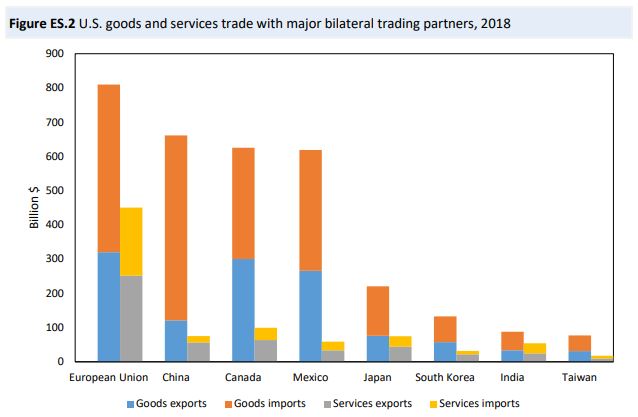
In 2018, Canada was the United States’ second-largest single-country trading partner after China for the fourth consecutive year. The value of U.S. two-way merchandise trade with Canada rose 6.1 percent to $617.1 billion in 2018, accounting for 14.7 percent of total U.S. merchandise trade with the world. Both U.S. merchandise exports and imports with Canada increased in 2018 from the previous year, but imports outpaced exports, resulting in a $2.6 billion increase (15.8 percent) in the U.S. merchandise trade deficit with Canada to $19.7 billion. Leading U.S. exports to Canada included crude petroleum; civilian aircraft, engines, and parts; motor vehicles—both for passengers and for goods transport—as well as their parts and accessories; and light oils. Top U.S. imports from Canada included crude petroleum; passenger motor vehicles and their parts and accessories; refined petroleum products; natural gas; and coniferous wood and products.
In 2018, Mexico was the United States’ third-largest single-country merchandise trading partner. U.S. two-way merchandise trade with Mexico amounted to $611.5 billion in 2018, an increase of 9.7 percent from 2017. Mexico accounted for 14.5 percent of U.S. trade with the world. U.S. merchandise exports to Mexico totaled $265.0 billion in 2018, and U.S. merchandise imports from Mexico amounted to $346.5 billion. Both U.S. merchandise imports and exports with Mexico increased in 2018 from the previous year. Leading U.S. exports to Mexico included light oils; refined petroleum products; computer parts and accessories; diesel engines; semiconductors; parts and accessories of bodies (including cabs) for motor vehicles; and civilian aircraft, engines, and parts. Leading U.S. imports from Mexico included passenger motor vehicles, motor vehicles for goods transport, telecommunications equipment, road tractors for semi-trailers, color TV reception apparatus, and insulated ignition wiring sets.
Global Economic Trends
Overall, the global economic growth rate fell slightly from 3.8% in 2017 to 3.6% in 2018. The slow global growth seen in 2018 is attributed to short-term uncertainty in economies due to trade tensions and financial pressures in emerging markets. The United States was the only economy to show improvement in it’s growth rate from 2017 to 2018.
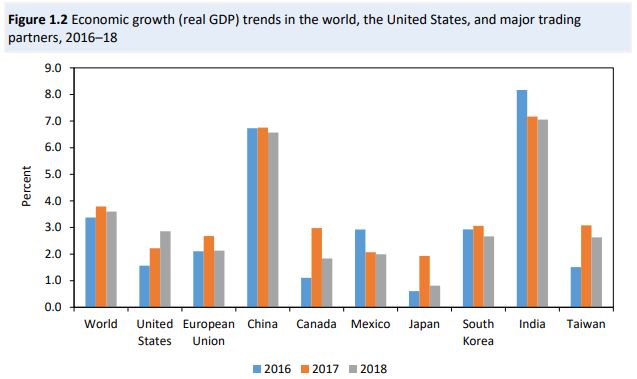
U.S. Dollar Exchange Rate Trends
The U.S. dollar appreciated in comparison to other currencies, rising 5.5% between January and December 2018. The previous year, the U.S. dollar depreciated by 6.3%. The upwards trend in 2018 was driven partly by the Federal Open Market Committee’s four interest rate hikes, along with a lower than expected unemployment rate.
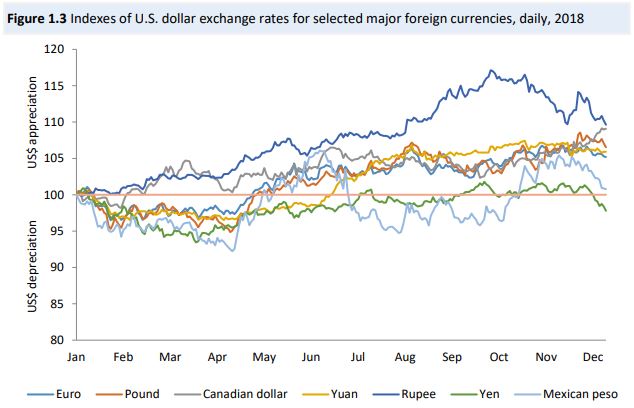
To read the full report, The Year in Trade 2018, published by the United States International Trade Commission, click here.
If your company has import or export needs, you should consider working with Logistics Plus. Global trade compliance management is as important as it has ever been. In the U.S. Logistics Plus more than a dozen locations that can help you with your transportation and logistics needs; and our Customs Brokerage staff can also help you clear customs for imports at any port in the United States. Additionally, Logistics Plus now has locations at 50 offices in over 20 countries. As always, you can find any of our worldwide employees in our online global directory.


by logisticsplus | Oct 30, 2018 | News
 Importing and exporting goods may seem like a daunting task. There have been 6 tariff changes already this year, along with 12 revisions to the Harmonized Tariff Schedule of the United States (HTSA). With constant tariff changes and revisions, importers may feel lost or confused. Logistics Plus Customs Broker Solutions can assist by providing peace-of-mind. Our licensed customs brokers ensure that you receive unparalleled customer service with personal attention to detail. Listen to these two WP$E radio audio clips containing interview snippets with Gretchen Blough, a licensed customs broker and Customs Brokerage Manager for Logistics Plus.
Importing and exporting goods may seem like a daunting task. There have been 6 tariff changes already this year, along with 12 revisions to the Harmonized Tariff Schedule of the United States (HTSA). With constant tariff changes and revisions, importers may feel lost or confused. Logistics Plus Customs Broker Solutions can assist by providing peace-of-mind. Our licensed customs brokers ensure that you receive unparalleled customer service with personal attention to detail. Listen to these two WP$E radio audio clips containing interview snippets with Gretchen Blough, a licensed customs broker and Customs Brokerage Manager for Logistics Plus.

Clip 1

Clip 2

Logistics Plus helps its customers in the following ways:
- We learn about your product and its function so that we know it’s classified properly.
- We can advise you in filing bindings rulings, if necessary, with U.S. Customs and Border Protection (CBP) for an added assurance that your classification is correct.
- We can look at your bills of materials to determine the correct country of origin.
- We can investigate if you qualify for first sale pricing to lower your declarable value.
- We work with several law firms that can file exclusion petitions on your behalf if you qualify for exclusion from the new tariffs.
- We match your imports against the Miscellaneous Tariff Act of 2018 to determine if your goods qualify for reduced or duty-free status.
By using the information above, Logistics Plus will be able to assist you in making better informed sourcing decisions. While other brokers may be larger, they cannot match the personal attention to detail that Logistics Plus Customs Broker Solutions offers. Our consulting services are available to any Logistics Plus shipping customer. Becoming a customer of Logistics Plus means that you gain immediate access to the peace-of-mind that comes from working with our compliance specialists. If you are not a Logistics Plus customer, you can also purchase our customs broker solutions as a stand-alone consulting service. Either way, we’re here to help!
Our team of customs brokers and global trade compliance experts will guide you through every complex step of the customs process. Contact us today for more information or click here to schedule a customized Global Trade Compliance seminar. You can also email us at cbs@logisticsplus.com.


by logisticsplus | Aug 28, 2018 | News
 The United States International Trade Commission (USITC) just released its updated “The Year in Trade 2017” report. This report covers all of the global trade trends from 2017. Included in this report are exchange rate trends, trade laws and regulations, global economic trends, regional trade activity, global trade agreements, and new trade relations, among other topics. Let’s take a look at some of the most intriguing and important trade trends that occurred in 2017.
The United States International Trade Commission (USITC) just released its updated “The Year in Trade 2017” report. This report covers all of the global trade trends from 2017. Included in this report are exchange rate trends, trade laws and regulations, global economic trends, regional trade activity, global trade agreements, and new trade relations, among other topics. Let’s take a look at some of the most intriguing and important trade trends that occurred in 2017.
Trade Activities With Major Trading Partners
As expected, China was again named the United States largest single-country trading partner based on two-way merchandise trade in 2017. Merchandise trade with China accounts for 16.4 percent of total U.S. trades and amounts to $635.9 billion in trade. Behind China is Canada for the third consecutive year. U.S. and Canada trade rose 7 percent from the previous year and amounted to $582.4 billion in 2017. Following China and Canada is Mexico with a value of $557 billion in 2017 trade. The figure below includes the top 7 single-countries the U.S. trades with, and also the E.U. which includes all countries the U.S. trades with in Europe.
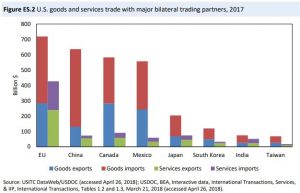
U.S. Exports and Imports
In 2017, transportation equipment was the largest U.S. export sector accounting for 21 percent of all exports. Close behind was electronics (17.3 percent), and chemical related products (14.7 percent). The top individual export product were civilian aircraft, engines, and parts, along with refined petroleum products. The biggest U.S. import in 2017 was electronic products, which totaled for 20.7 percent of U.S. imports. On an individual basis, passenger motor vehicles were the largest U.S. import valued at $186.4 billion. China was once again the leading source of U.S. imports in 2017.
Exchange Rate Trends
Overall, the U.S. dollar depreciated in 2017, falling 6.3 percent on the broad dollar index. This downward trend was mainly driven by the depreciation of the U.S. dollar compared to other major world currencies. The U.S. dollar fell by 12 percent against the euro, 9.4 percent against the pound (UK), 6.8 percent against the Canadian dollar, and 6.1 percent against the Mexican peso. Several major U.S. investment banks noted that the euro and pound were recovering from an early drop due to the uncertainty of the Brexit vote. The figure below shows the U.S. dollar exchange rate compared to other major world currencies.
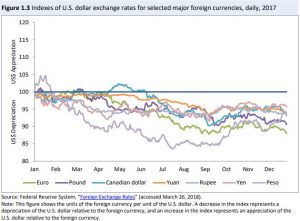
U.S. GDP in 2017
The United States had a $19.4 trillion economy in 2017, and the economy grew faster in 2017 than it did in 2016. U.S. real gross domestic product (GDP) increased 2.3 percent in 2017 compared to the growth rate of 1.5 percent in 2016. The main factors driving this high growth rate were due to four industries- professional and business services; finance, insurance, real estate, rental, and leasing; manufacturing; and retail trade.
To read the full report, The Year in Trade 2017, published by the United States International Trade Commission, click here.
If your company has import or export needs, you should consider working with Logistics Plus. In the U.S. we have more than a dozen locations that can help you with your transportation and logistics needs; and our Customs Broker Solutions staff can also help you clear customs for imports at any port in the United States. Additionally, Logistics Plus now has locations at 50 offices in 22 countries. As always, you can find any of our worldwide employees in our online global directory.


by logisticsplus | Feb 6, 2018 | News
 Chinese New Year is the first day of the year in the Chinese calendar. Chinese New Year is also known as the Spring Festival in modern China, or simply the Lunar New Year, is the most important and longest of all Chinese holidays. The first day of the Chinese New Year 2018, the year of the dog will be celebrated Thursday, February 15, 2018, until February 21, 2018. As you might imagine, given the prominence of Chinese global commerce, the holiday has a huge impact on global supply chains around the world.
Chinese New Year is the first day of the year in the Chinese calendar. Chinese New Year is also known as the Spring Festival in modern China, or simply the Lunar New Year, is the most important and longest of all Chinese holidays. The first day of the Chinese New Year 2018, the year of the dog will be celebrated Thursday, February 15, 2018, until February 21, 2018. As you might imagine, given the prominence of Chinese global commerce, the holiday has a huge impact on global supply chains around the world.
Government, construction, and factories are generally closed for most of the Spring Festival (including the Logistics Plus offices in China), while ports and customs usually operate with a skeleton staff focusing on perishable priority items. Many manufacturers treat the holiday as an annual break and will subsequently shut down for two weeks or longer. With this year’s holiday falling a full 19 days later than it did in 2017, the 2018 Chinese New Year will be different, with normal freight flows resuming in mid-to-late March, according to John Paul Hampstead, staff writer for FreightWaves.com.
If you have Chinese imports or exports, hopefully, you have already planned ahead for this annual supply chain disruption (most suppliers have probably already stopped accepting orders until after the holiday). Different manufacturers might have different schedules, so it is best to coordinate individually with each of your overseas suppliers. Planning and coordination are key to ensuring your supply chain continues to run smoothly before, during, and after the Chinese New Year.
If you need help shifting your supply chain back into high-gear following the Chinese New Year, the global import & export experts at Logistics Plus are here to help. As a top freight forwarder and NVOCC, we can help you secure affordable air freight and ocean freight transportation, and we can provide you with customs brokerage and global trade compliance support. Shipping documents (e.g., BOL entry, arrival notice, custom filings), tariff filings, VGM submissions, cargo tracking, freight rate management, and more – we’ve got you covered! Once your goods arrive in the U.S., we can provide warehousing and fulfillment, and transportation solutions as needed too. Contact us today!

PS: As a reminder, Logistics Plus China offices will also be closed from February 15 through February 21 for the holiday. Those offices will resume normal operations on February 22. During that time period, all other Logistics Plus locations stand ready to help you with your international shipping needs.
Page 3 of 6«12345...»Last »

![]()





 The United States International Trade Commission (
The United States International Trade Commission (




 Importing and exporting goods may seem like a daunting task. There have been 6 tariff changes already this year, along with 12 revisions to the
Importing and exporting goods may seem like a daunting task. There have been 6 tariff changes already this year, along with 12 revisions to the 





